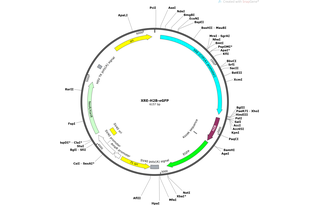-
PurposeFluorescent reporter for AhR activity
-
Depositing Labs
-
Sequence Information
Ordering
| Item | Catalog # | Description | Quantity | Price (USD) | |
|---|---|---|---|---|---|
| Plasmid | 182294 | Standard format: Plasmid sent in bacteria as agar stab | 1 | $85 | |
Backbone
-
Vector backboneH2B-GFP
-
Backbone manufacturerGeoff Wahl Lab (Addgene #11680)
- Backbone size w/o insert (bp) 1646
- Total vector size (bp) 6157
-
Modifications to backboneCMV promotor was removed and replaced by XRE sequence.
-
Vector typeMammalian Expression
-
Selectable markersNeomycin (select with G418)
Growth in Bacteria
-
Bacterial Resistance(s)Kanamycin, 50 μg/mL
-
Growth Temperature37°C
-
Growth Strain(s)DH5alpha
-
Copy numberHigh Copy
Gene/Insert
-
Gene/Insert nameXenobiotic Response Element
-
Alt nameXRE
-
Alt nameCYP1A1 promotor
-
SpeciesH. sapiens (human)
-
Insert Size (bp)1646
-
Entrez GeneCYP1A1 (a.k.a. AHH, AHRR, CP11, CYP1, CYPIA1, P1-450, P450-C, P450DX)
- Promoter XRE
-
Tag
/ Fusion Protein
- eGFP (C terminal on insert)
Cloning Information
- Cloning method Restriction Enzyme
- 5′ cloning site AseI (unknown if destroyed)
- 3′ cloning site BglII (unknown if destroyed)
- 5′ sequencing primer ATTAATGCTTCTGGCACATAGTAGTT
- 3′ sequencing primer AGATCTGAGCTCAGCTGGGAAG (Common Sequencing Primers)
Terms and Licenses
-
Academic/Nonprofit Terms
-
Industry Terms
- Not Available to Industry
Trademarks:
- Zeocin® is an InvivoGen trademark.
These plasmids were created by your colleagues. Please acknowledge the Principal Investigator, cite the article in which the plasmids were described, and include Addgene in the Materials and Methods of your future publications.
-
For your Materials & Methods section:
XRE-H2B-eGFP was a gift from Severine Degrelle & Thierry Fournier (Addgene plasmid # 182294 ; http://n2t.net/addgene:182294 ; RRID:Addgene_182294) -
For your References section:
Novel fluorescent and secreted transcriptional reporters for quantifying activity of the xenobiotic sensor aryl hydrocarbon receptor (AHR). Degrelle SA, Ferecatu I, Fournier T. Environ Int. 2022 Sep 24;169:107545. doi: 10.1016/j.envint.2022.107545. 10.1016/j.envint.2022.107545 PubMed 36179647





